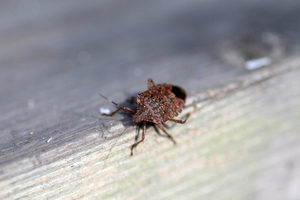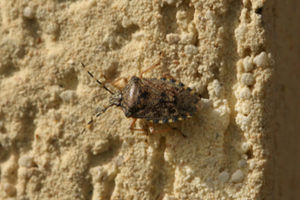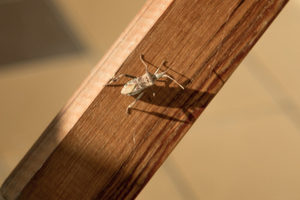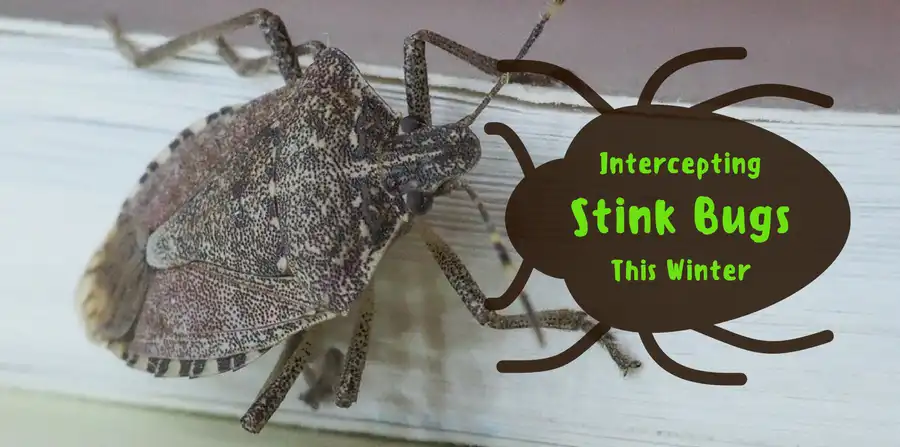Unlike many other pests in our part of the world, stink bugs don’t infest homes during the spring or summer. Instead, Michigan’s newest neighbor tends to start infesting homes in late fall and early winter. If you see a stink bug in your home come early spring, it’s probably because it spent winter with you.
We know that’s not exactly great news. Stink bugs survive winter by getting cozy in shelter and basically going dormant until spring comes. But, as we keep our homes nice and warm, it’s not uncommon to see a few stink bugs in your home during the winter. If you don’t want to run into them in a few months, you should consider intercepting them now. Here’s everything you need to know to do it.
How They Survive
 When temperatures drop, stink bugs enter a special hibernation-like state called diapause. Diapause dramatically slows down the stink bug’s metabolism, allowing it to survive without food for long periods of time. Instead of feeding, stink bugs in diapause burn through nutrients they spent the spring and summer stockpiling. Basically, they fatten themselves up for winter just like squirrels.
When temperatures drop, stink bugs enter a special hibernation-like state called diapause. Diapause dramatically slows down the stink bug’s metabolism, allowing it to survive without food for long periods of time. Instead of feeding, stink bugs in diapause burn through nutrients they spent the spring and summer stockpiling. Basically, they fatten themselves up for winter just like squirrels.
Stink bugs have to enter diapause in winter because the fruits, seeds, and nuts they feed on aren’t available. It solves their food problem, but they’re on their own when it comes to the cold problem. Stink bugs are native to Southeast Asia, and never developed adaptations to help them survive cold. Even if they entered diapause outside, their bodies would freeze and they would die. Unfortunately, that’s where your home comes in. Stink bugs try to sneak into structures for one reason: to keep warm and sleep away the winter.
Where They Go
 Stink bugs enter buildings via the same access points most pests find. Usually, they crawl through cracks and crevices around door and window frames or utility lines. Stink bugs fly and climb surfaces, so they may use vents, chimneys, or roofing damage to get in, as well. It’s only after stink bugs infiltrate a home successfully that their behavior becomes a bit more unique.
Stink bugs enter buildings via the same access points most pests find. Usually, they crawl through cracks and crevices around door and window frames or utility lines. Stink bugs fly and climb surfaces, so they may use vents, chimneys, or roofing damage to get in, as well. It’s only after stink bugs infiltrate a home successfully that their behavior becomes a bit more unique.
When stink bugs enter diapause, they can’t move and only have a minimal awareness of their surroundings. They have to be very careful about where they enter diapause if they ever want to wake back up! Once inside, stink bugs shack up in the quietest, most inaccessible or forgotten part of your home. They might be in air vents, under appliances, behind walls or flooring, or even hiding inside furniture. You’ll probably never find stink bugs inside unless you go looking for them.
Are they a Problem?
 No. When stink bugs enter homes, it’s only ever to stay warm while they sleep away the winter. They don’t eat or infest your food, damage structural material, create nests, mate, or lay eggs. In fact, stink bugs won’t begin their mating season or lay eggs in spring until after they’ve left your home. Pretty considerate of them, really. The pests don’t transmit diseases or harm humans and pests in any other way, either.
No. When stink bugs enter homes, it’s only ever to stay warm while they sleep away the winter. They don’t eat or infest your food, damage structural material, create nests, mate, or lay eggs. In fact, stink bugs won’t begin their mating season or lay eggs in spring until after they’ve left your home. Pretty considerate of them, really. The pests don’t transmit diseases or harm humans and pests in any other way, either.
That being said, there is the matter of their name. Stink bugs… stink. When threatened or startled, they secrete a foul-smelling liquid from a scent gland. The scent has been compared to cilantro or coriander. The secretion is mostly harmless, though it may trigger allergic reactions or stain fabrics in concentrated amounts. Stink bugs may also produce a pheromone that attracts other stink bugs to their location. A lot of stink bugs aren’t any more dangerous or destructive than a few, but they are stinkier.
What To Do About Them
 First, vacuum up the stink bugs you find with a shop vac. Remove and dispose of the vacuum bag into an outdoor dumpster when you’re finished. Clean the surfaces where you find stink bugs with soapy water and a washcloth. Try not to crush stink bugs when you find them, because they’ll release their scent on death. Remember to check the secluded or hidden areas where stink bugs like to hide. Cleaning these areas regularly will make them far less attractive to the pest.
First, vacuum up the stink bugs you find with a shop vac. Remove and dispose of the vacuum bag into an outdoor dumpster when you’re finished. Clean the surfaces where you find stink bugs with soapy water and a washcloth. Try not to crush stink bugs when you find them, because they’ll release their scent on death. Remember to check the secluded or hidden areas where stink bugs like to hide. Cleaning these areas regularly will make them far less attractive to the pest.
When you’ve removed all the stink bugs you can find, focus on locating where they got in. Look for cracks and crevices around baseboards, door and window frames, the foundation, or insulation. Seal up cracks with caulk to prevent additional bugs from following residual scent left behind by the first infestation. Stink bugs’ bodies are quite flat, so even small cracks provide them with enough room to sneak through.
Stink bugs aren’t the most disruptive of winter pests, but you shouldn’t have to share your home with them. Come spring, any stink bugs you don’t find now will make themselves apparent, often in upsetting ways. Luckily, by getting to know stink bugs and following these steps, you can ensure that doesn’t happen.
And if ever you need some help ensuring that doesn’t happen, you know who to call. We’ve been fighting stink bugs since they showed their ugly mugs in Michigan, and we’re pretty good at it. Give us a call anytime and we’ll make sure you head into spring smelling good.

